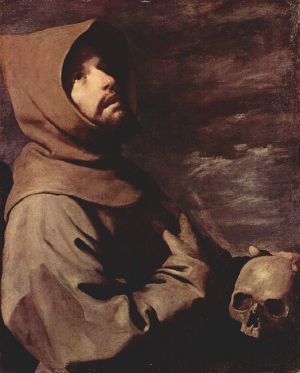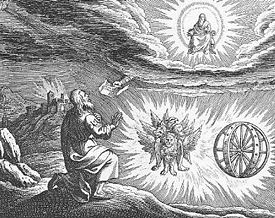Beatific Vision

The Beatific Vision is a term in Catholic theology describing the direct perception of God enjoyed by those who are in Heaven, imparting supreme happiness or blessedness. In this view, humans' understanding of God while alive is necessarily indirect (mediated), while the Beatific Vision is direct (immediate). Outside of Catholicism, as well as in Catholic and other Christian mystical tradition, many hold that it is possible to experience God directly while still on earth.
Biblical tradition is ambivalent as to whether God can be perceived directly by humans on earth. Several biblical prophets reported seeing God, or at least an aspect of him. Eastern Christian tradition holds that humans can experience theosis (divinization) while still on earth, and many saints reported visions of God. However, the Beatific Vision came to be defined more narrowly than this.
Thomas Aquinas explained the Beatific Vision as the ultimate goal of human existence after physical death. Aquinas' formulation of beholding God in Heaven parallels Plato's description of beholding the Good in the world of the Forms, which is not possible while still in the physical body. However, Aquinas himself is believed by some to have experienced the Beatific Vision just before his own death, prompting him to declare his written works "like straw."
The Beatific Vision as defined in Catholic theology should not be confused with other mystical experiences such as the attainment of a unitive state with God, visionary revelations from angels, or glimpses of an aspect of God. However, some have argued that the Catholic definition of the Beatific Vision makes it unattainable even in Heaven, while at the same time discouraging those who seek mystical experience with God on earth.
Ancient Judaism
Ancient Judaism took a somewhat ambivalent attitude on the subject. The Book of Genesis, early Psalms, and other works preserve a tradition in which God is visibly seen. Adam and Eve walk and talk with God in the God of Eden (Gen. 2-4), and Psalm 18:8, for example, describes a vision of God in clearly anthropomorphic terms: "Smoke rose from his nostrils; consuming fire came from his mouth, burning coals blazed out of it."
In Exodus 33:20, however, God says to Moses, "you cannot see my face, for no one may see me and live." This passage came to typify the later Jewish and Christian attitude that God cannot be fully perceived while a person is still alive. However, the prophet Isaiah reported "I saw the Lord seated on a throne, high and exalted, and the train of his robe filled the temple." (Isaiah 6:1) Later, Ezekiel stopped just short of claiming to have seen God himself, describing instead a vision "the likeness of the glory of the Lord."
High above on the throne was a figure like that of a man. I saw that from what appeared to be his waist up he looked like glowing metal, as if full of fire, and that from there down he looked like fire; and brilliant light surrounded him. Like the appearance of a rainbow in the clouds on a rainy day, so was the radiance around him. This was the appearance of the likeness of the glory of the Lord (Ezekiel 1:26-28).
Such apocalyptic imagery gave rise to a mystical tradition in Judaism which usually followed Ezekiel's line of carefully avoiding any claim to have seen God directly, while reporting in detail various visions of the heavenly chariot or throne on which God sits, the glory of God, the heavenly Temple, angels, and other orders of heavenly beings. However, Talmudic tradition generally did not encourage even this type of mystical activity.
Platonism
The philosophy of Plato hints at the concept of the Beatific Vision in the Allegory of the cave, which appears in the Republic Book 7 (514a-520a), speaking through the character of Socrates:
My opinion is that in the world of knowledge the idea of good (the Good) appears last of all, and is seen only with an effort; and, when seen, is also inferred to be the universal author of all things beautiful and right, parent of light and of the lord of light in this visible world, and the immediate source of reason and truth in the intellectual (517b,c).
For Plato, the Good appears to correspond to God in Christian theology. Plato held that those still in the physical body were prevented from a full perception of the Good, seeing only, as it were, shadows cast by a fire onto the wall of a cave. Platonic attitudes came to influence Christian theology, which developed in the Roman Empire. St. Augustine expressed views similar to Plato's on this subject, and was familiar with Plato's ideas, either directly or via the writings of Neoplatonists.
New Testament
The New Testament reports numerous heavenly visions, although it is debatable whether any of these constitutes the Beatific Vision. Various reports of visitation from angels clearly do not fall into this category. However, several instances are reported of Jesus, while still alive on earth, having extraordinarily direct communion with God, such as at his baptism and transfiguration. Moreover, Jesus tells his disciples: "Blessed are the pure in heart, for they will see God" (Matthew 5:8).
In the Book of Acts, Saint Stephen, just before his death, stated: "I see heaven open and the Son of Man standing at the right hand of God." In addition, Saint Paul hints that he has had a vision so powerful that he dare not speak of it:
I will go on to visions and revelations from the Lord. I know a man in Christ who fourteen years ago was caught up to the third heaven⊠I know that this manâwhether in the body or apart from the body I do not know, but God knowsâwas caught up to paradise. He heard inexpressible things, things that man is not permitted to tell. I will boast about a man like that, but I will not boast about myself, except about my weaknesses (2 Cor. 12: 1-5).
In 2 Peter 1, the promise is given that Christians became "partakers in the divine nature," a scripture used by Christian mystics, of the eastern tradition to justify the doctrine of theosis or divinization. Finally, the Book of Revelation reports numerous visions of God and this throne. For example:
At once I was in the Spirit, and there before me was a throne in heaven with someone sitting on it. And the one who sat there had the appearance of jasper and carnelian. A rainbow, resembling an emerald, encircled the throne (Revelation 4:2-3).
Christian tradition
Catholic theology, however, took the view that the true Beatific Vision is impossible to achieve while still on earth. The term is defined by the Catholic Encylopedia as "The immediate knowledge of God which the angelic spirits and the souls of the just enjoy in Heaven." In Catholic theology, the intercession of saints is valid because those who have died in the faith are with God in Heaven and enjoy the Beatific Vision, that is, unmediated access to God's presence.

St. Cyprian of Carthage (third century) wrote of the saved seeing God in the Kingdom of Heaven.
How great will your glory and happiness be, to be allowed to see God, to be honored with sharing the joy of salvation and eternal light with Christ your Lord and God⊠to delight in the joy of immortality in the Kingdom of Heaven with the righteous and God's friends.
However, other saints and mystics hint a direct vision of God while still in the flesh. Two major themes of Christian mysticism are 1) a complete identification with Christ, thus participating in his divine nature; and 2) the perfect vision of God, in which the mystic seeks to experience God "as he is," and no more "through a glass, darkly" (1 Corinthians 13:12).
In his work The Ladder, Saint John Climacus describes how to raise one's soul and body to God, as if on a ladder, the goal of which is theosis (mystical union with God). The later tradition of Hesychasm used meditative practices designed to eventually experience God directly as "Uncreated Light." Saint Teresa of Avila wrote of the "devotion of union," an ecstatic state in which the faculty of reason is absorbed in God, characterized by a blissful peace, a conscious rapture in the love of God.
Formalizing the Beatific Vision
In the thirteenth century, philosopher-theologian Thomas Aquinas, following his teacher Albertus Magnus, described the ultimate goal of a human life as consisting in the intellectual Beatific Vision of God's essence after death. According to Aquinas, the Beatific Vision surpasses both faith and reason. Rational knowledge does not fully satisfy humankind's innate desire to know God, since reason is primarily concerned with sensible objects, and thus can only infer its conclusions about God indirectly.
Faith, too, is incomplete, since Aquinas thinks that it always implies some imperfection in the understanding. The believer does not wish to remain merely on the level of faith, but to understand fully, to know God. Only the fullness of the Beatific Vision satisfies this fundamental desire of the human soul to know God. Quoting St. Paul, Aquinas notes "We see now in a glass darkly, but then face to face" (I Cor. 13:12). The Beatific Vision is the final reward for those saints elect by God to partake in and "enjoy the same happiness wherewith God is happy, seeing him in the way which He sees Himself" in the next life.
However, before finishing his Summa Theologica, Aquinas reportedly experienced ecstatic visions, ceased all writing, and declared: âAll that I have written seems to me like straw compared to what has now been revealed to me.â Some believe that, ironically, Aquinas himself experience the Beatific Vision on earth after arguing that it could only be experienced in Heaven.
Pope John XXII (1316-1334) held that the saved do not attain the Beatific Vision until Judgment Day, thus negating the idea that the Beatific Vision is enjoyed by those currently in Heaven. Catholics are quick to point out that his opinion was not expressed ex cathedra and therefore does not constitute official Catholic doctrine. In any case, the College of Cardinals held a consistory on the problem in January 1334, and the pope withdrew his view. An official declaration issued by his successor, Benedict XII, in 1336 stated:
Since the passion and death of the Lord Jesus Christ, these [pure] souls have seen and see the divine essence with an intuitive vision and even face to face, without the mediation of any creature by way of object of vision; rather the divine essence immediately manifests itself to them, plainly, clearly and openly, and in this vision they enjoy the divine essence⊠Also the souls of those who will die in the future will see the same divine essence and will enjoy it before the general judgment. [1]
Other traditions

Later Christian tradition, as well as various mystical trends in other religions, often speak of direct visions of God. Hindu and Buddhist thought have long spoken of the experience of samadhi, in which the soul finds union with the divine while still in the body. The mystical tradition in Islam speaks of literally seeing with God's eyes: "When I love him, I am his hearing by which he hears; and his sight by which he sees; his hand by which he strikes; and his foot by which he walks" (Hadith of An-Nawawi 38).
George Fox and the other early Quakers believed that direct experience of God was available to all people, without mediation. Later Christian mysticism, unencumbered by fears of being declared heretical, became ever more bold in its verbal expression of direct spiritual perceptions of God. New Age and psychedelic philosophies also speak of direct experiences with God while still in the body, or sometimes temporarily out of it.
Yet, such experiences may not be the same as that defined by the Beatific Vision. Indeed, few if any of those who report to have experienced God directly ever claim that what they have perceived is the entirety of God, or that others would necessarily perceive God the same way. Catholic tradition continues to insist that, while many may experience God in a limited or mediated sense while still in their physical bodies, the true Beatific Vision is unavailable to those on earth.
Notes
- â www.ewtn.com, BENEDICTUS DEUS. Retrieved September 13, 2008.
ReferencesISBN links support NWE through referral fees
- Hergan, Jeffrey P. St. Albert the Great's Theory of the Beatific Vision. New York: P. Lang, 2002. ISBN 978-0820457901
- Hoye, William J. Actualitas Omnium Actuum: Man's Beatific Vision of God As Apprehended by Thomas Aquinas. Monographien zur philosophischen Forschung, Bd. 116. Meisenheim (am Glan): Hain, 1975. ISBN 978-3445011176
- Lossky, Vladimir, and Vladimir Lossky. The Vision of God. Leighton Buzzard, Bedfordshire: Faith Press, 1973. OCLC 1050091
- Ugwaka, Patrick Ifeanyichukwu. Beatific Vision As Prefigured in the Gospel of the Transfiguration: A Dogmatic Study of the Teachings of the Popes from Leo the Great Through John XXII to Benedict XII. Romae: Pontificia universitas Urbaniana, 2001. OCLC 55070159
- Valliparambil, José. The Beatific Vision of Christ. Romae: Pontificia Universitas Sanctae Crucis, Facultas Theologiae, 1999. OCLC 52074047
Credits
New World Encyclopedia writers and editors rewrote and completed the Wikipedia article in accordance with New World Encyclopedia standards. This article abides by terms of the Creative Commons CC-by-sa 3.0 License (CC-by-sa), which may be used and disseminated with proper attribution. Credit is due under the terms of this license that can reference both the New World Encyclopedia contributors and the selfless volunteer contributors of the Wikimedia Foundation. To cite this article click here for a list of acceptable citing formats.The history of earlier contributions by wikipedians is accessible to researchers here:
The history of this article since it was imported to New World Encyclopedia:
Note: Some restrictions may apply to use of individual images which are separately licensed.

